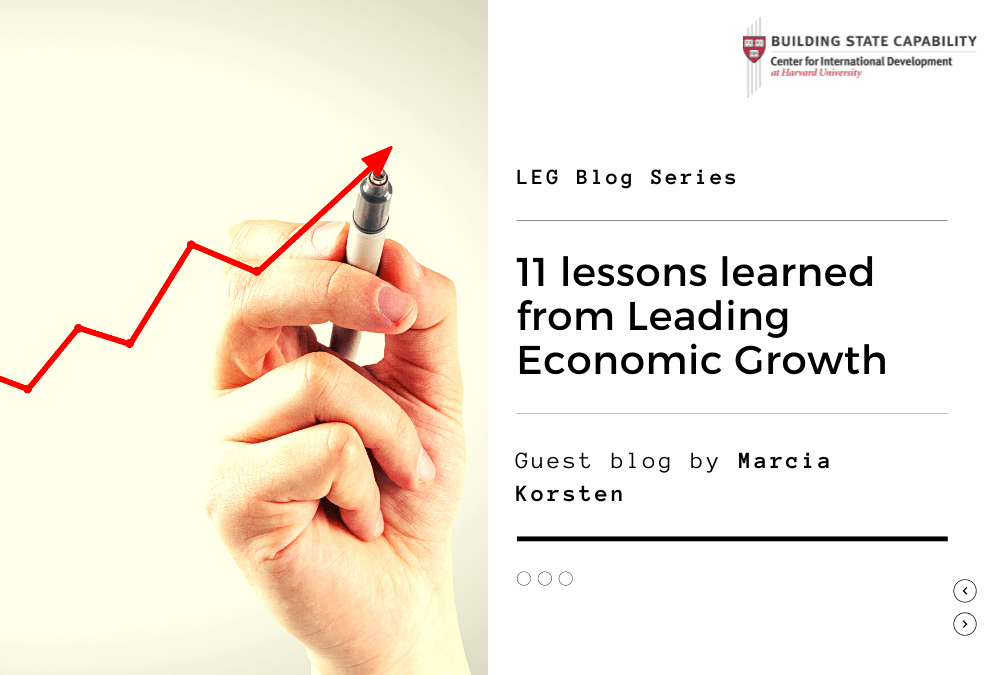Guest blog by Marcia Korsten
A great thing about this programme is that it highlighted that context matters for an economic growth strategy and that unique and differentiated approaches that fit the specific context are needed. On the other hand, another great thing is that the lessons and principles of Leading Economic Growth can be applied across various economic growth and development challenges and within a national and subnational context. Looking at the economic challenge of inclusive growth and jobs I have experienced both as part of LEG 2021 and as a member of Group 11 where I was fortunate to collaborate with a great group of peers over the course of the programme, I am sharing 11 of my lessons and insights. These lessons and insights inform my thinking and practice within the economic, policy, strategy and innovation space.
- The ‘why’ matters. Reflecting on why growth matters is an important part of understanding the growth problem or challenge your region or country may be facing. Maybe economic growth matters because the nature and pace of economic growth needs change to create jobs or to address inequality or increase incomes. Why it matters is also linked to who it matters to. When you know why it matters, you can work out what it would look like solved and what changes are needed.
- Inclusive growth is a complex problem. There is no clear roadmap for tackling inclusive growth and it can be approached from different perspectives which may have multiple possible solutions. There are unknowns to tackling complex problems with dynamic interdependencies and many different stakeholders. This complexity requires interactions and engagements amongst various agents or stakeholders to inform the diagnosis and possible entry points to start taking action.
- Let the strategy emerge. Doing many small things, can have a big impact if its focused on the causes of the problem, where there is space for change and solutions are sought and actioned in an iterative manner. An action driven, learning focused, adaptive approach to the strategy can help close the gap between policies and implementation. Applying a Problem-Driven Iterative Adaptation (PDIA) Approach allows for focus on a problem, understanding the problem before deciding on a solution and learning about the problem while trying to solve it.
- The importance of knowhow. Accumulating knowhow is an important part of the economic development process. A different way of looking at economic growth is as a process of diversifying the productive knowhow in your city, region or country to produce a more diverse set of goods and services. Looking at your export basket or products your country produces is one way of telling if there is diversity of knowhow in certain sectors. Regions and countries can actively pursue strategies to create new knowhow through opportunities between neighbouring countries and countries with strong business, social, and cultural connections.
- Taking a capabilities approach to growth. This includes building problem solving capability, capability to improve intra and intergovernmental and external coordination, processes of businesses working together with government for growth and use of multidisciplinary teams to bring new solutions and innovation and a new and different way of doing things. It is about connecting and bringing capabilities together local solutions fit for local context. Where there are stumbling blocks to building capabilities, these should be identified and addressed.
- High bandwidth organisations. Growth strategies require high-bandwidth or highly connected organisations that are more information-intensive, learning, and adaptive in identifying problems and organising around the capabilities needed to address it. Ways to do foster a high bandwidth organisation could include: establishing coordination/collaboration mechanisms across spheres of government to work in a more integrated manner, creating opportunities between government and private sector to share information and innovative budgeting for resource mobilisation supporting multi-agency problem solving or identifying high bandwidth organisations to work with.
- Binding constraints and economic opportunities. Conducting a growth diagnostic and understanding what is restricting growth assists in designing a strategy for growth. Space and place matters and principles of binding constraints and doing a growth diagnostic can be applied at national, subnational levels.
- Growth through inclusion. A multidimensional and integrated approach to growth and inclusion recognise that it is no longer feasible to separate between economic and social development. Inclusion is a strategy for growth particularly when focused on improving productivity.
- Inclusive growth needs an inclusive growth process. Growth and inclusiveness cannot be achieved by governments alone – interactions of government with private sector is needed to combine complementary inputs to produce higher productivity goods/services and jobs. An integrated and inclusive policy process for the growth strategy tries to get as many people into the process.
- Be innovative. Ideas to start identifying solutions to growth challenges can come from best practice (external), existing practice, latent ideas (ideas that are out there but need to be extracted) and positive deviance (local best practice). Considering all these various areas may bring about a few options to start working on.
- Leadership is key. Growth strategy is about both the content and the process, and therefore leadership is an important part of economic growth and development. Leading economic growth is also about leading change and doing things differently. It is about managing complexity, being adaptive, taking innovative approaches to address constraints and creating and capitalising on opportunities. Multi agency leadership is across levels with various leadership roles from those who need to authorise, resource and implement growth strategy to those who need to convene, motivate teams working on growth challenges to those who identify problems and come up with ideas.
This is a blog series written by the alumni of the Leading Economic Growth Executive Education Program at the Harvard Kennedy School. 61 Participants successfully completed this 10-week online course in December 2021. These are their learning journey stories.
